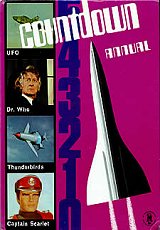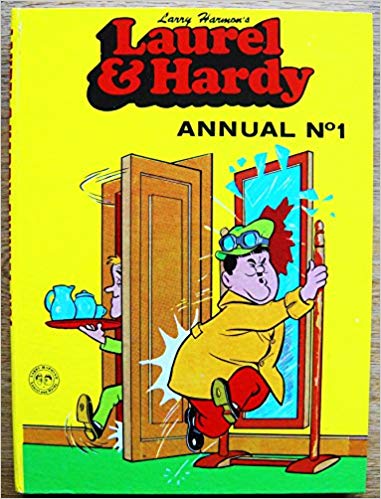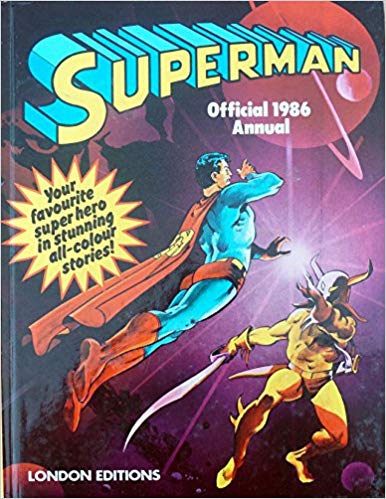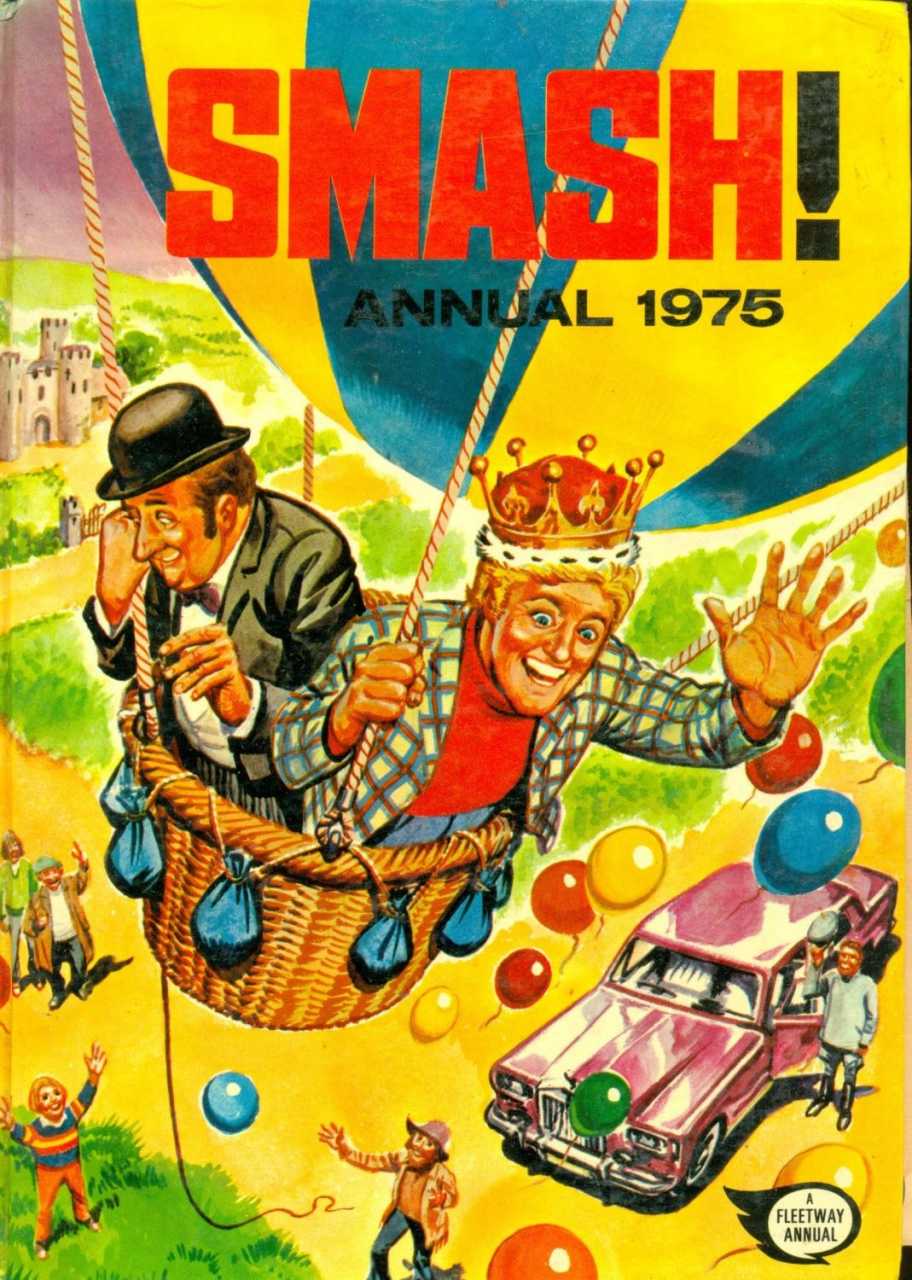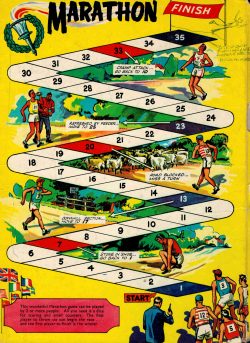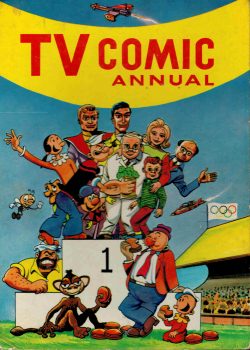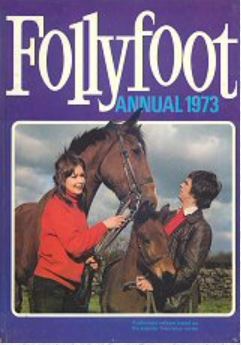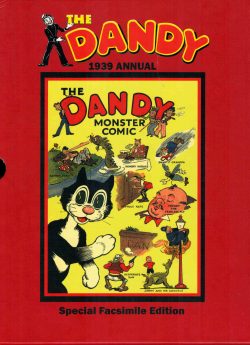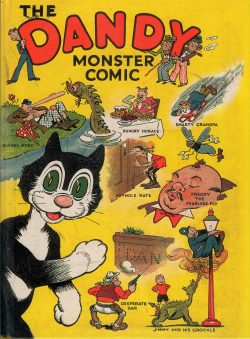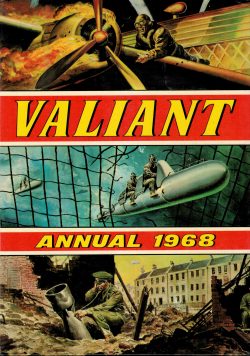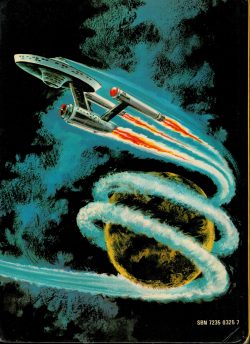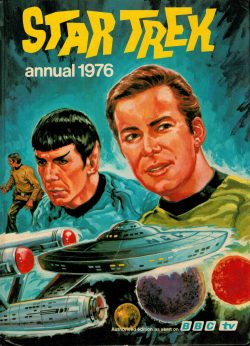In keeping with my self-imposed Holiday tradition here’s another pick of British Annuals selected not just for nostalgia’s sake but because it’s my house and my rules…
After decades when only American comics and memorabilia were considered collectable or worthy, the resurgence of interest in home-grown material means there’s lots more of this stuff available and if you’re lucky enough to stumble across a vintage volume or modern facsimile, I hope my words convince you to expand your comfort zone and try something old yet new…
Still topping my Xmas wish-list is further collections from fans and publishers who have begun to rescue this magical material from print limbo in (affordable) new collections…
Great writing and art is rotting in boxes and attics or the archives of publishing houses, when it needs to be back in the hands of readers once again. As the tastes of the reading public have never been broader and since a selective sampling of our popular heritage will always appeal to some part of the mass consumer base, let’s all continue rewarding publishers for their efforts and prove that there’s money to be made from these glorious examples of our communal childhood.
Look and Learn Book 1964
By various (Fleetway)
No ISBN
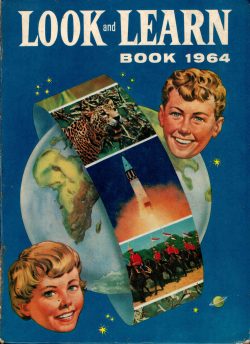
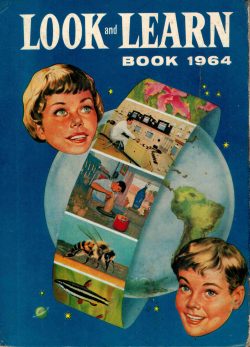
One of the most missed of publishing traditions in this country is the educational comic. From the features in legendary icon The Eagle to the small explosion of factual and socially responsible boys’ and girls’ papers in the late 1950s, to the heady go-getting heydays of the 1960s and 1970s, Britain had a healthy sub-culture of kids’ periodicals that informed, instructed and revealed – and don’t even get me started on sports comics!
Amongst many others, Speed & Power, World of Wonder, Tell Me Why and the greatest of them all, Look and Learn, spent weeks over decades making things clear and bringing the marvels of the world to our childish but avid attentions. Moreover, when we had no screens of our own, it was all accomplished with wit, style and – thanks to the quality of the illustrators involved – astonishing beauty and clarity.
Look and Learn launched on 20th January 1962, the brainchild of Fleetway Publications Director of Juvenile Publications Leonard Matthews, and executed by Editor David Stone (almost instantly replaced by John Sanders), Sub-Editor Freddie Lidstone and Art Director Jack Parker.
For twenty years and 1049 issues. the comic delighted children by bringing the marvels of the universe to their doors, and became one of the county’s most popular children’s weeklies. Naturally, there were many spin-off tomes such as The Look and Learn Book of 1001 Questions and Answers, Look and Learn Book of Wonders of Nature, Look and Learn Book of Pets and Look and Learn Young Scientist, as well as the totally engrossing Christmas treat The Look and Learn Book.
Selected simply because it has a lovely and inclusive painted cover, this volume – released for Christmas 1963 (as with almost all UK Annuals they were forward-dated) is a prime example of a lost form. Within this168-heavy-stock-paged hardback are 49 fascinating features on all aspects of human endeavour and natural wonder from And in the beginning there was FIRE, Let’s Look at Canada, How this Book was Printed, It’s On the Map!, The Muscle Menders, When Man Goes to Mars, Every Carpet Tells a Story, The Charm of Canterbury, Puzzle Pix, Art Gallery in an Album, Photo Know-How, The Queen’s Bodyguard, Why Do Camels Have Humps? and dozens more articles, all cannily designed to beguile, enthral and above all else, inspire young minds.
Lavishly illustrated with photographs, diagrams, infographics, and paintings and drawings by some of the world’s greatest commercial artists including such luminaries as Ron and Gerry Embleton, Don Lawrence, Helen Haywood, Ron Turner, Ken Evans, Angus McBride, Severino Baraldi, Graham Coton, Ralph Bruce, Cecil Langley Doughty and many others, these books were an utter delight for hungry minds to devour whilst the turkey and Christmas pudding were slowly digested…
Earlier editions such as this one also valued literary entertainment and hands-on activity: providing illustrated extracts from classic books (as here with ‘Midshipman Easy Goes to Sea’ by Captain Frederick Marryat and illuminated poems ‘The Fall of Ratisbon’ by Robert Browning and William Wordsworth’s ‘An Evening Walk’) and hobby crafts as seen in a vast and detailed section on ‘How to build Model Boats’ – complete with plans and blueprints.
With the internet and TV, I suppose their like is unnecessary and irrelevant, but nostalgia aside, the glorious pictures in these volumes alone make them worth the effort of acquisition, and I defy any child of any age to not be sucked into the magic of learning stuff in such lively, lovely style…
© Fleetway Publications Ltd 1963. All Rights Reserved.
Hotspur Book for Boys 1975
By Many & various (DC Thomson)
Retroactively awarded ISBN: 978-0-85116-077-1
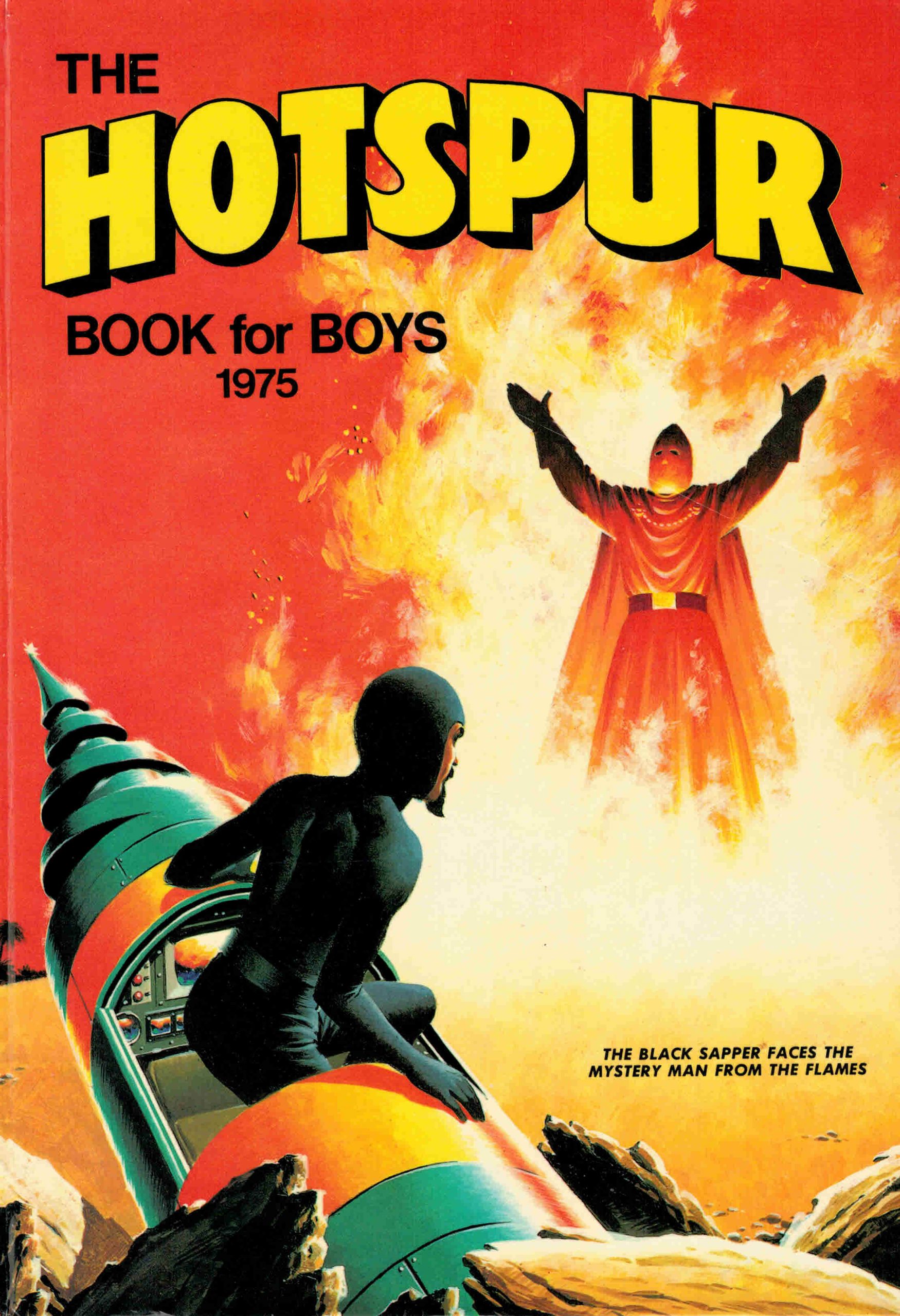
If you grew up British any time after 1960 and read comics, you probably cast your eye occasionally – if not indeed fanatically – over DC Thompson’s venerable standby The Victor.
The Dundee based publisher has long been a mainstay of British popular reading and arguably the most influential force in our comics industry. Its strong editorial stance and savvy creativity is responsible for a huge number of household names over many decades, through newspapers, magazines, books and especially its comics and prose-heavy “story-papers†for Girls and Boys.
That last category – comprising Adventure, Rover, Wizard, Skipper and Hotspur – pretty much-faded out at the end of the 1950s when the readership voted overwhelming with their pocket money in favour of primarily strip-based entertainments…
The last of those venerable all-prose story-papers wasn’t dormant for long. Cover-dated 24th October 1959, Hotspur the comic seamlessly replaced the prose stalwart (which had run from 2nd September 1933 to October 17th 1959) as a (mostly) pictorial serial package, running for 1110 weekly issues until finally folding into Victor with the January 24th1981 edition. It was very much the company’s weird and wonderful repository, like a general interest magazine for kids but with strange and exotic leanings. It was always heavy on bizarre situations and splendidly esoteric superheroes. Hostspur Annuals ran from 1966 to 1992 and were an unmissable fact of many a boy’s Yule loot…
This particular example hit the shops in September 1974, and behind that Ian Kennedy (?) cover opened with a two-coloured fact frontispiece exploring ‘Oil from under the Sea – the Finders’. The feature is mirrored at the end with ‘Oil from under the Sea – the Keepers’.
‘The Black Sapper’ was reformed criminal turned globetrotting troubleshooter: a brilliant engineer who built a mighty mechanical Worm-ship ship to travel beneath the Earth. He transferred to Hotspur from The Beezer, and was illustrated by Jack Glass, Keith Shone and Terry Patrick, who here details how the adventurer extinguishes an Arabian oil fire and scotches a sinister plot to usurp the king, after which we’re clued in on industrial ‘Deep Sea Fishing’.
Combining football and nautical adventure, comedy yarn ‘The Rust Bucket Rovers’ (John Richardson art?) sees soccer-crazed Pacific islanders contending with a multinational crew to clear a cargo, after which hearty spoof ‘Grizzly Grant’(Mike Dorey, or perhaps CD Bagnall) finds a junior Mountie and his ursine assistant battle frontier crime.
Tank commander ‘Blake of the Ironfists’ (Peter Sutherland?) then wins a major engagement in WWII Africa, leading to Dorey’s ‘Willie the Winner’ entering yet more contests with hilarious outcomes, before a 1941 naval blockade is overcome by doughty British mariners in ‘HMS Dent – the Deadly Decoy’.
The secrets of ‘Coastal Fishing’ segue into more mirth as motor racing pioneers ‘Spick and Spanner’ compete on a snowbound course in the Italian Alps after which veteran star ‘Iron Teacher’ and his handler Special Agent Jake Toddtackle an evil hypnotist with designs on a circus.
The history of ballooning in ‘Up, Up and Away!’ neatly proceeds into Great War saga ‘Hasket’s Battle Basket’, after which ‘Last of the Warriors’ sees a Cheyenne cavalry scout solving a murder mystery before slapstick oaf ‘Ossie the Outlaw’ proves again that for him crime does not pay…
After aviation pioneer ‘Skyscraper Kidd’ crashes his flying machine on a desert island and thinks his way home, time-displaced highwayman ‘Nick Jolly’ (and his robot flying horse) do their best to make Christmas unforgettable at a ski resort and mega department store in a rousing romp from Ron Smith whilst ‘Parker’s Barkers’ sees the rundown pooches of a local kennel humiliate the elite racers of the local dog track
Fact feature ‘The King of the Tankers’ leads into Z-Cars spoof ‘The Voice of the Panda’ before serious drama returns as football star ‘Cracker Jackson’ takes some sage advice to get over his psychological barriers. After learning all about ‘The World’s Biggest Shovel’, it’s back to desert islands where castaway WWII survivors ‘Thudd and Blunder’ deal with a native uprising in a manner simply not acceptable to today’s audiences.
Stealing the show is Ron Smith’s captivatingly odd teen hero ‘Red Star Robinson’ who – with the invaluable assistance of his android butler Mr. Syrius Thrice – thwarts The Spider‘s plan to steal England’s crown jewels, after which ‘Heavyweights’ details a selection of massive transport options before the fun wraps up in anarchic hilarity as clod-footed ‘Dim Dan the Boobyguard’ (Dorey?) tries escorting his own boss to a crucial meeting and everybody else pays the price for his eager ineptitude…
Divorcing the sheer variety of content and entertainment quality of this book from simple nostalgia may be a healthy exercise but it’s almost impossible. I’m perfectly happy to luxuriously wallow in the potent emotions this annual still stirs. It’s a fabulous read from a magical time and turning those stiffened two-colour pages is always an unmatchable Christmas experience… happily one still relatively easy to find these days.
You should try it…
© DC Thomson & Co., Ltd., 1974.
Hurricane Annual 1969
By Many & various (Fleetway)
SBN: 900376-04-X
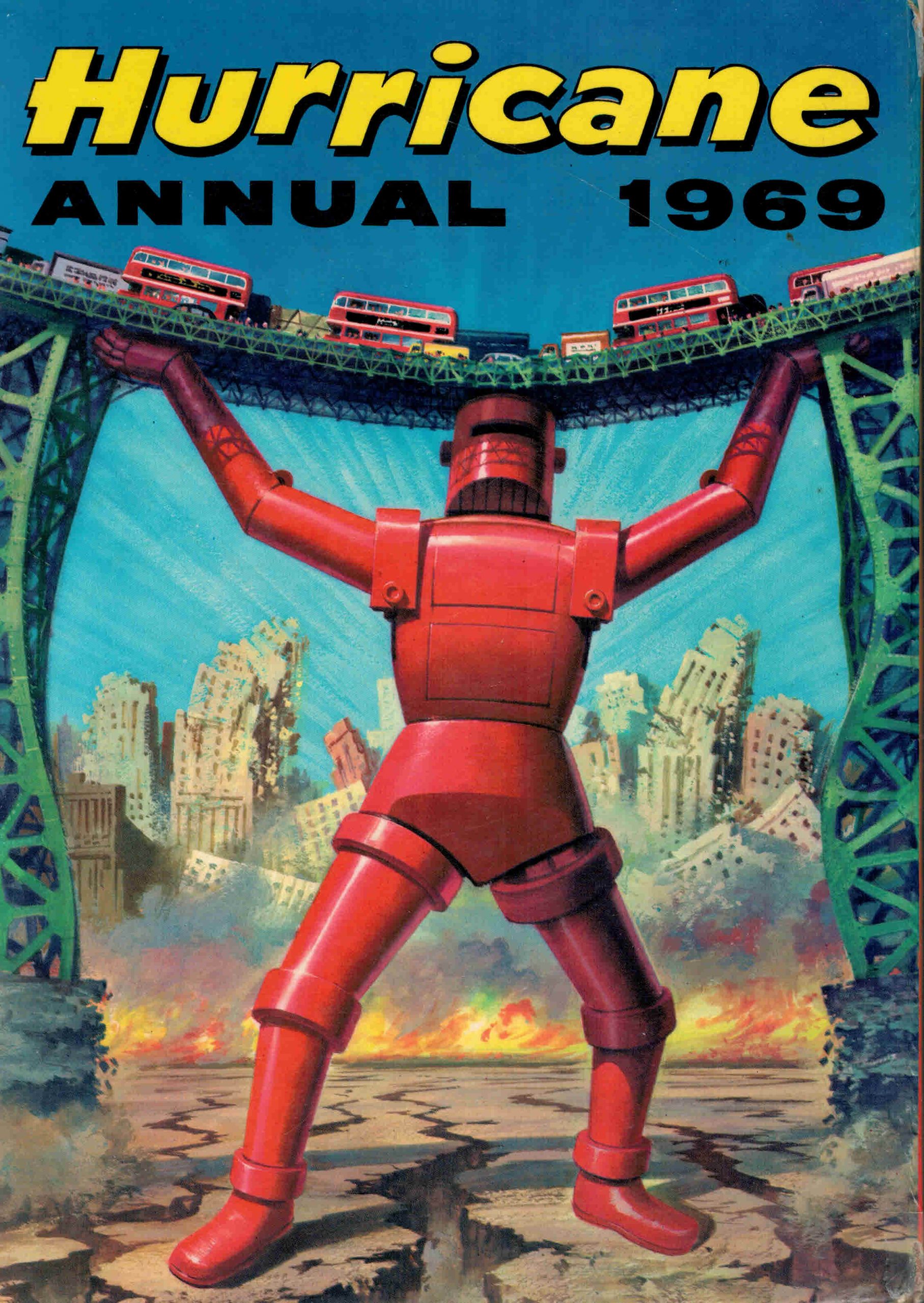
From the late 1950s and increasingly through the 1960s, Scotland’s DC Thomson steadily overtook their London-based competitors – monolithic comics publishing giant Amalgamated Press.
Created by Alfred Harmsworth at the beginning of the twentieth century, AP perpetually sought to regain lost ground, and the sheer variety of material the southerners unleashed as commercial countermeasures offered incredible vistas in adventure and – thanks to the defection of Leo Baxendale and Ken Reid to the enemy – eventually found a wealth of anarchic comedy material to challenge the likes of the Bash Street Kids, Dennis the Menace, Minnie the Minx and their unruly ilk.
During the latter end of that period the Batman TV show sent the entire world superhero-crazy. Amalgamated had almost finished absorbing all its other rivals such as The Eagle‘s Hulton Press to form Fleetway/Odhams/IPC and were about to incorporate American superheroes into their heady brew of weekly thrills.
Once the biggest player in children’s comics, Amalgamated had stayed at the forefront of sales by latching onto every fad: keeping their material contemporary, if not strictly fresh. The all-consuming company began reprinting the early successes of Marvel comics for a few years; feeding on the growing fashion for US style adventure which had largely supplanted the rather tired True-Blue Brit style of Dan Dare or DC Thompson’s Wolf of Kabul.
Even though sales of all British comics were generally – and in some cases, drastically -declining, the 1960s were a period of intense and impressive innovation with publishers embracing new sensibilities; constantly trying new types of character and tales. At this time Valiant and its stable-mate Lion were the Boys’ Adventure big guns (although nothing could touch DC Thomson’s Beano and Dandy in the comedy arena).
Hurricane was an impressive-looking upgrade that began during that period of expansion and counterattack, apparently conceived in response to DCT’s action weekly Hornet. It launched the week of February 29th 1964 and ran for 63 issues, but was revamped three times during that period before ultimately being merged into companion paper Tiger.
It carried a superbly varied roster of features in that that time, including two (and a half) stars who survived its extinction. Racing driver Skid Solo and comedy superman Typhoon Tracy as well as Sgt Rock – Paratrooper… but not for so long for him…
There was heavy dependence on European and South American artists initially, among them Mario Capaldi, Nevio Zeccara, Georgio Trevisan, Renato Polese and Lino Landolfi, some of whom lasted into the Annuals. As with so many titles, although the comics might quickly fade, Christmas Annuals sustained their presence for years after Hurricane seasonal specials were produced for every year from 1965 to 1974…
Following a tried-&-true formula, this book – published in 1968 – offers comics adventures, prose stories, fact-features, and funnies and puzzles, kicking off with visual vexations in ‘Fantastic – but True!’ before western star Drago joins an embattled cavalry troop in staving off an invasion from Mexico (no, really!) in duo-hued thriller ‘The Gun that Saved the West’ – possibly illustrated by Renato Polese.
‘The Worst Boy in the School’ – as illustrated by Geoffrey Whittam? – was a long-running boarding school saga enlivened by its star Duffy coming from Circus stock. Here the comedy chaos and espionage excitement stems from the boys trying to keep an escaped chimp and parrot secret from the Masters…
‘Two Fists Against the World!’ was a Regency-set strip featuring prize-fighter Jim Trim. Illustrated by Carlos Roume, this origin reprint sees how, in 1804, the husky orphan first sets out on his pugnacious path…
‘Casey and the Champ’ then details in strip form the last hurrah of a broken-down steam engine as prelude to a text feature of weird facts corralled here as ‘It Was the Way Out West’ feature. Truly gripping prose yarn ‘The Vanished Wreck’then recounts how a clever insurance scam is foiled by an inventive salvage crew, before Typhoon Tracy – Extra Special Agent stars in ‘Mad, Mad Mission’: baffling spies and American agents in equal measure with his blundering rescue of a kidnapped boffin. Switching back to prose, Rex Barton, Investigator of the Weird and Unknown foils a cunning robbery in ‘The Phantom Monks of Milborough’.
Following the comedy capers of ‘Rod the Odd Mod and ‘is old pal Pervy Vere’, pictorial history lesson ‘Into Battle with King-Sized Catapults!’ and ‘Safari Quiz’ segue into a thrilling prose sci-fi short illustrated by immaculate stylist Reg Bunn. ‘Hunt for the Human Time-Bomb!’ stars atomic accident survivors Ace Sutton and Flash Casey who use their abilities to walk through walls to avert imminent catastrophe, after which The Robot Builders (drawn by what looks like early Massimo Bellardinelli?) attend a New World symposium and experience ‘All the Fear of the Fair!’ when a giant mechanical brain goes haywire…
Masked cowboy ‘The Black Avenger’ then exposes a fake sheriff before we jump to luscious full-colour as the worst ship in the WWII navy again confounds the British Admiralty and escapes being broken up for parts in ‘HMS Outcast in the Big Scrap’. Geoff Campion’s unruly mob here stave off doom and dispersal by implausibly capturing an Italian super dreadnaught in the Mediterranean…
‘Defeat for the ‘Boy General’ – the True Story of Custer’s Last Stand’ gives a fairly jaundiced review of the cavalryman’s career (backed up by visuals from contemporary movie Custer of the West) whilst ‘War Under the Sea’ offers technical speculation on the development of the Oceans, ending the colour section and leading into monochrome soccer star Harry of the Hammers who wins his cup-tie after first foiling a robbery in prose piece ‘Mystery Marksman’…
After gag magician ‘Marvo Brings the House Down’, Giovanni Ticci limns a sublime light-hearted ‘Sword for Hire’ romp starring Cavalier soldier-of-fortune Hugo Dinwiddie who pawns his blade but still manages to save the day against burglars and bandits, and racer Geoff Hart wins a war of wills and wheels in ‘Stock-Car Duel!’
Sport was a major fascination of publishers at this time and ‘Soccer Special by The Ref’ opens an extended section of pictorial mini-features comprised of ‘Cap-and-Cup Winners’, ‘Before they were Famous’, ‘Odd Things Happen in Soccer’ and ‘They Made Soccer History’, before full-on fantasy returns with cover-star ‘The Juggernaut from Planet Z’, who revisits his Earth chum Dr. Dan Morgan and foils alien invaders employing tectonic terror tactics.
Another outing for Rod the Odd Mod and ‘is old pal Pervy Vere brings us to prose fable ‘The Impostor Knight’, revealing how an affable blacksmith’s assistant wins a joust, augmented by fact-filled sidebar ‘Warriors in Armour’ before ‘Sgt. Rock – Special Air Service’ is assigned to destroy a Nazi fuel dump and ‘Typhoon Tracy Trouble-Shooter’ riotously ends a revolution far, far South of the Border in his own inimitable incompetent manner…
Mischievous moppet ‘Terrible Tich’ literally brings the house down and ‘Wild West Funmen’ offers a magazine of owlhoot hoots before the nostalgia-fest closes in spectacular style as Hugo Dinwiddie stalks a flamboyant highwayman and ends up as a ‘Courier for the King!’
Eclectic, wide-ranging and always of majestically high quality, this blend of fact, fiction, fun and thrills is a splendid evocation of lost days of joy and wonder. We may not be making books like this anymore but at least they’re still relatively easy to track down. Of course, what’s really needed is for some sagacious publisher to start re-issuing them…
© Fleetway Publications Ltd., 1968

